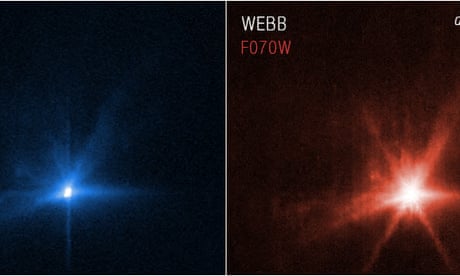- by foxnews
- 08 Apr 2025
Nasa releases images of ‘planetary defense test’ as spacecraft crashed into asteroid
Nasa releases images of ‘planetary defense test’ as spacecraft crashed into asteroid
- by theguardian
- 30 Sep 2022
- in news

Nasa has released the first detailed images of its pioneering deep-space "planetary defense test" in which a spacecraft was crashed into a distant asteroid in an attempt to alter its trajectory.
The pictures were taken by what the agency calls its "two great observatories", the James Webb and Hubble space telescopes, which captured Monday's impact on Dimorphos, moon of the asteroid Didymos, 6.8m miles from Earth.
Photographs of the $325m Dart (double asteroid redirection test) mission were combined into two colorful time-lapse animations showing the spacecraft's approach, and then the brightness of the moment of collision.
Alongside the animations, which were posted to Nasa's website on Thursday, are a number of before and after still images showing the impact and vivid spikes of ejecta, the rocky surface material from the asteroid thrown out by the force of the collision.
"Webb and Hubble show what we've always known to be true at Nasa: we learn more when we work together," Bill Nelson, the agency's administrator and former astronaut, said in a statement accompanying the images.
"For the first time, Webb and Hubble have simultaneously captured imagery from the same target in the cosmos: an asteroid that was impacted by a spacecraft after a 7m-mile journey. All of humanity eagerly awaits the discoveries to come from Webb, Hubble, and our ground-based telescopes, about the Dart mission and beyond."
Mission managers said at a post-impact press conference on Monday that it could be up to two months before it is known whether the force of the Dart impact was enough to move Dimorphos from its regular orbital path around Didymos.
Scientists will monitor its movements and speed through ground-based telescopes for any divergence, as well studying data from Webb's mid-infrared instrument and near-infrared spectrograph.
But they were exuberant about the "game-changing" successful completion of the first part of the mission. The Dart program's deputy manager, Elena Adams, said the craft struck Dimorphos head on, only 17 meters from its target.
"It was basically a bullseye. I think, as far as we can tell, the first planetary defense test was a success, and we can clap to that," she said.
The Dart mission was marked humanity's first attempt at moving another celestial body in an unprecedented test of Nasa's capacity to defend Earth from the doomsday scenario of a large asteroid hurtling towards it.
- by foxnews
- descember 09, 2016
Ancient settlement reveals remains of 1,800-year-old dog, baffling experts: 'Preserved quite well'
Archaeologists have recently unearthed the remarkably well-preserved remains of a dog from ancient Rome, shedding light on the widespread practice of ritual sacrifice in antiquity.
read more


